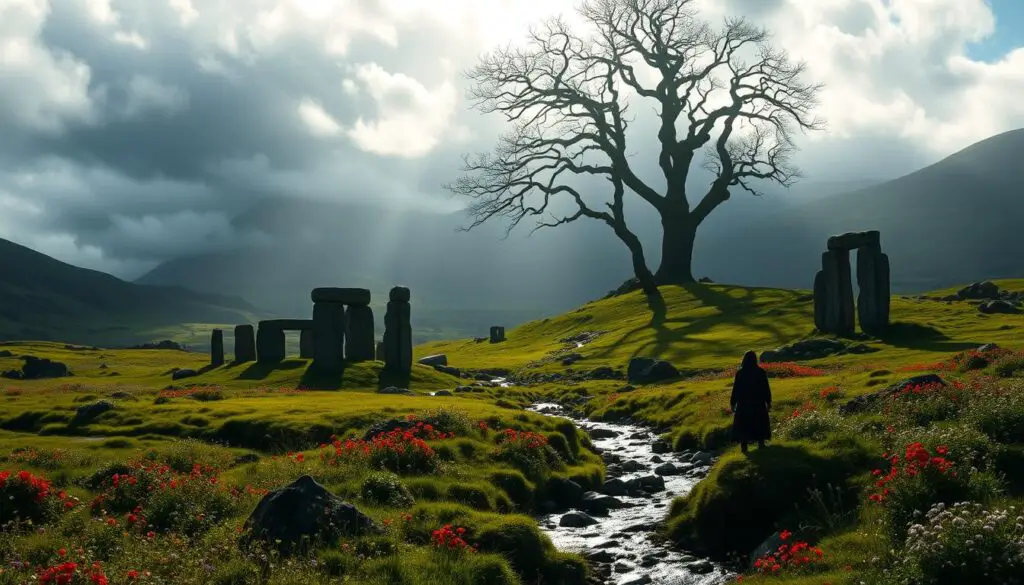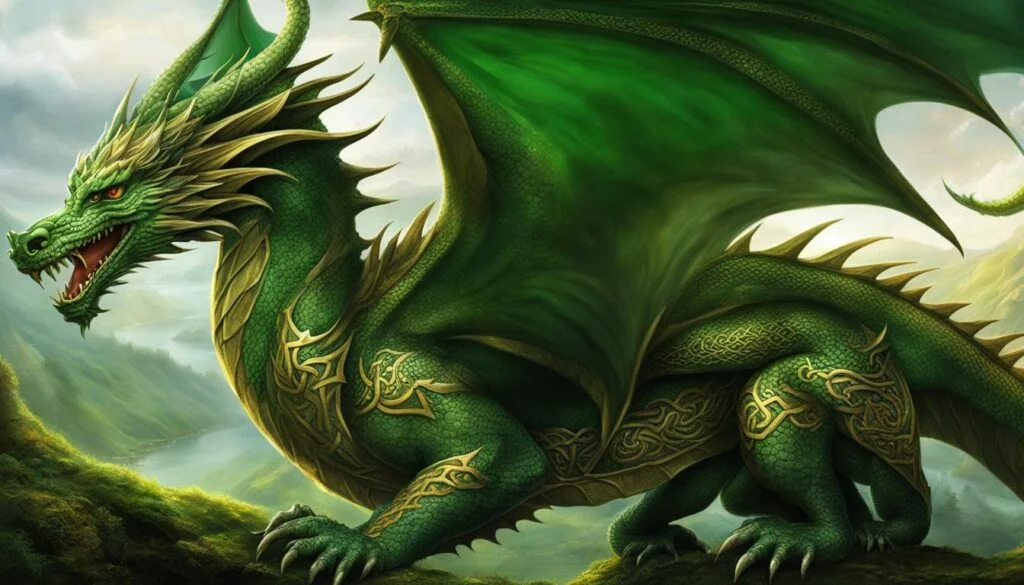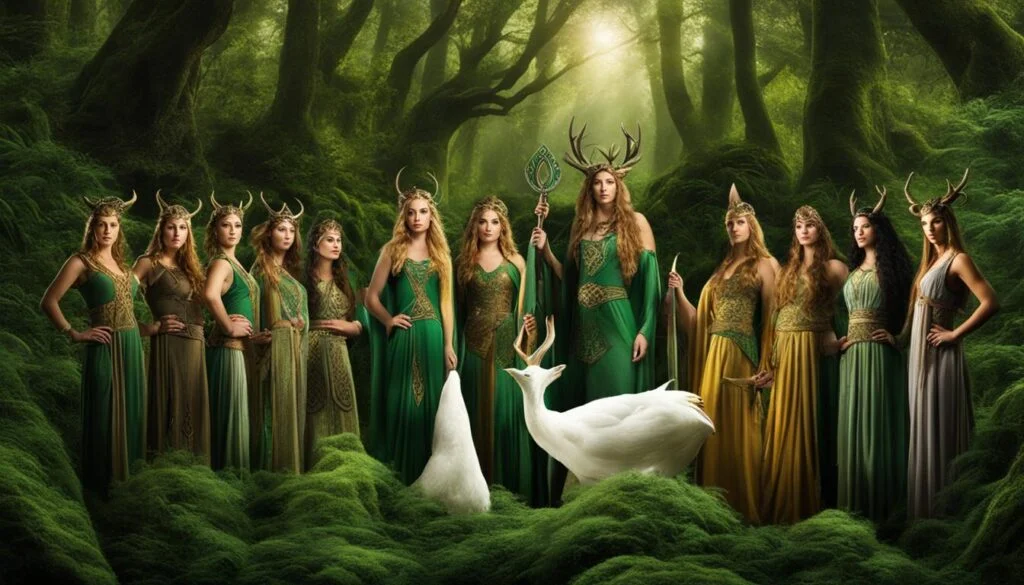Irish mythology is full of stories about settlers and legendary figures.
Cessair is a key figure, often seen as one of the first to settle in Ireland. The story of Ireland’s start, in the Lebor Gabála Érenn or the Book of Invasions, is different from others. It doesn’t tell of a creation story.
Instead, Ireland has always been there, and people came to settle over time.
Cessair’s group is thought to have been the first.
Key Takeaways
- Irish mythology offers a unique perspective on the origin of Ireland through legendary settlements.
- Cessair is widely recognized as one of the earliest figures to set foot in Ireland.
- Unlike other cultures, Ireland’s origin story is rooted in timeless existence and tribal invasions.
- The Lebor Gabála Érenn is a pivotal text for understanding these ancient legends and the lore of Ireland settlers.
- Cessair’s journey symbolizes the rich Celtic heritage that continues to fascinate scholars and enthusiasts alike.
Introduction to Cessair and the First Settlers of Ireland
In the rich tapestry of Irish origin stories, Cessair is a key figure.
She led a group of women and a few men to find a sin-free land before the great Biblical flood.
This journey started Ireland’s habitation.
Cessair’s group had forty-nine women and three men. They sailed on three ships, but two got lost.
They finally reached Dún na mBarc on Bantry Bay, forty days before the flood.
This moment is full of legend and is mentioned in old stories like the Annals of the Four Masters.
Fintan survived the flood by changing into different animals.
He lived for 5,500 years. He told the High King Diarmait mac Cerbaill about Ireland’s story, mixing myth with history.
The story of Cessairians coming to Ireland is part of Irish mythology.
It shows the deep roots of Irish culture.
Some stories say 150 women came with the three men.
They were like Irish land goddesses, including Banba, Fódla, Ériu, and their husbands.
These tales show the deep cultural meaning of the settlers’ arrival.
Old texts like Lebor Gabála Érenn tell Cessair’s story. These stories are found in many old books, like the Book of Leinster.
They show the mythical side of Irish stories.
Looking into these Irish origin stories helps us see how myth shapes our culture and identity in Ireland today.
Lebor Gabála Érenn: The Book of Invasions

The Lebor Gabála Érenn, also known as The Book of Invasions, tells the story of Ireland’s mythological past.
It was written in the 11th century. This book mixes stories and supposed events to show how Ireland came to be.
The Historical Texts and Their Significance
The Lebor Gabála Érenn is a big manuscript with over a dozen versions. It covers Ireland’s history from the start of the world to its making.
It’s divided into ten parts.
It tells of Cessair, who came with three men and fifty women, starting the first invasion.
After their sad end, Fintan mac Bóchra saw Ireland change.
Then, Partholón came from Sicily with five thousand men and four thousand women.
They fought the Fomoire and faced a plague. Later, Nemed and his people faced a big flood that nearly wiped them out.
Main Themes and Narratives in the Book
At the heart of The Book of Invasions are stories of winning, surviving, and starting anew.
It talks about the Túatha Dé Danann, magical beings who won battles. Then, the Milesians came from Scythia and Egypt to avenge their kin, Íth.
The book mixes real and made-up stories. For example, Partholonians brought farming to Ireland.
This mix of stories and facts creates a deep Irish story that lasts through time.
The book is full of names and places that show different cultures. Names like Partholón and Íth link to outside sources.
Places like Mag Ítha and Lough Foyle make the stories feel real.
From the Túatha Dé Danann’s magic to Partholón’s people’s battles, Lebor Gabála Érenn is a key text.
It mixes the magical with the real to shape Irish stories.
The Mythical Voyage of Cessair
The story of Cessair starts with a big dream to find a new land free from sin.
She built three ships to escape a big flood, like Noah’s Ark. With fifty women and three men, they set off on a seven-year trip to the world’s edge.
The Journey from the East
Cessair’s journey began in the East. She wanted to find a safe place before a big flood came.
They faced many challenges on their way.
Only one ship made it out of three. They traveled through Spain and finally saw the western edge from a tall tower.
This journey showed their strong will to survive and find safety.
Navigating to the Western Edge of the World
Getting to the western edge was hard. Cessair showed the spirit of Irish myths, looking for a new, pure land.
When they reached Ireland in 2361 BC, only 50 women and 3 men were left.
They formed groups led by the men who survived.
This journey shows how humans can face crises and start anew.
When Cessair arrived in Ireland, it was a key moment in its history.
Their story shows the strong human spirit. It also started many myths and stories in Irish folklore.
Cessair’s voyage still inspires us today, with themes of lasting through hard times, surviving, and hoping for a better future.
Cessair’s Companions: The Fifty Women and Three Men

The story of Cessair and the first settlers she brought to Ireland is fascinating.
She came with three men and fifty women. This group was ready for a new start after the Great Flood.
Cessair led her followers in three ships. Sadly, two ships sank at sea.
Only fifty women and three men, Bith, Ladra, and Fintan, made it to Ireland. They started their new life in Dun na mBarc.
The women were split into three groups. Fintan took seventeen women, and Bith did the same.
Ladra took sixteen women. This showed how they planned to build a new society together.
Fintan is famous for his story of changing into a salmon. He lived for thousands of years.
His story shows how important these early settlers were in Irish culture.
After forty days, a flood killed most of them. Only Fintan and Banba survived.
Their story tells of survival, loss, and new beginnings. These themes are key in Irish myths.
Arrival in Ireland: The Significance of Donemark
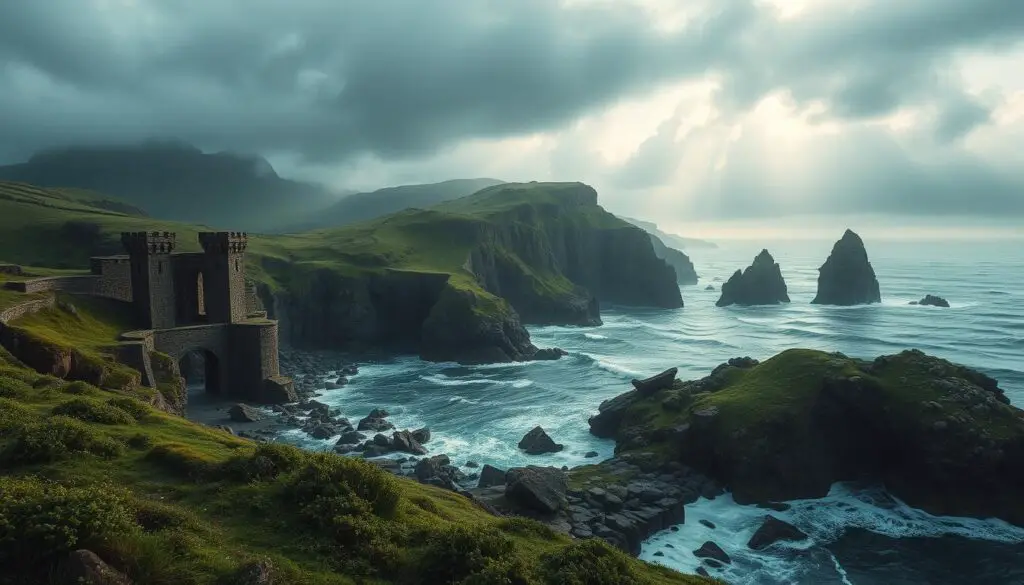
Cessair and her friends came to Ireland long ago. They landed at Donemark on Bantry Bay’s shore.
This place is important in Irish stories and history. It’s where they first set foot in Ireland around 2680 BC.
Cessair was Noah’s granddaughter. She and her group were looking for a safe place from a big flood.
Donemark means “place of the boat”. It’s a key spot in Irish history and stories.
Geographic and Symbolic Importance
Donemark is not just a place on the map. It’s also a symbol. It’s where the first human stepped foot, starting Ireland’s story.
This is told in the Lebor Gabála Érenn, or the Book of Invasions.
This land was seen as untouched and pure. Cessair wanted to find a place free from sin and disaster. Donemark became a symbol of a new start after a big disaster.
Becoming the First Footsteps on Irish Soil
Cessair’s arrival at Donemark marked the start of Ireland’s history. Her first steps and those of her group are part of Ireland’s story. They are tied to its geography and culture.
“Cessair’s story is enshrined in the tapestry of Irish lore. Every legend and saga following her arrival traces its roots back to those initial steps on Donemark.”
Local stories tell of a magical well and other legends at Donemark.
These stories link Donemark to Ireland’s myths. A boat sculpture, “Voyage of Stories,” by Michael Ray in 2013, honors Cessair’s arrival.
The stories of Donemark mix myth with reality.
This makes Donemark a key part of Irish history and stories.
The Role of Cessair in Irish Mythology

Cessair’s story is very important in Irish history. She led fifty women and three men to Ireland. This was the start of a new life for them.
Connection to the Great Flood
Cessair is linked to the Great Flood in Irish stories, like Noah’s story.
She tried to escape the flood and landed in Ireland. This shows how important she was in Irish history.
Her story tells us she was a strong leader. She survived the flood and found a new home.
All other ships were lost, making her journey even more special.
Symbolism of Cessair’s Journey
Cessair’s journey is full of deep meanings. She came to Ireland, leaving sin behind. This meant a new start for people.
She wanted to fill Ireland with life, bringing fifty women and three men.
This shows her wish to create and bring new life. Even though she and her friends died, her story teaches us about hope and overcoming big challenges.
Cessair was more than a leader. She was seen as powerful and connected to nature.
Her story is a symbol of new beginnings in Ireland.
Comparing Cessair to Other Mythological Figures

The story of Cessair is special in Irish mythology. It has unique parts that are part of Ireland’s culture.
It is often compared to the story of Noah’s Ark because both deal with surviving a big flood.
Parallels with Noah’s Ark
Cessair and Noah’s Ark both tell stories of survival during floods.
They show how strong humans can be. Noah’s Ark is a key part of Judeo-Christian stories, talking about God’s wrath and saving people.
Cessair’s story is also about survival and hope. But it has its own special setting and meaning.
Unlike Noah’s Ark, which focuses on a family and animals, Cessair’s story is about fifty women and three men going to the end of the world.
Distinctive Traits of Irish Mythology
Looking at Cessair compared to other figures shows what makes Irish legends unique.
Irish stories often talk about cleaning and don’t have serpents, unlike many other myths.
This is seen in Cessair’s story and is important in Ireland’s spiritual stories.
Stories like St. Patrick, who drove snakes out of Ireland, add to this idea of purity.
This makes Irish myths stand out. They mix well with Ireland’s deep stories of the Tuatha Dé Danann and other gods.
Aviation and Cessair: Drawing Modern Parallels

Cessair’s story is like today’s quest for new discoveries. It shows how we always want to explore and reach new heights.
This is true in aviation too, where we keep pushing to go further.
The Concept of Exploration in Ancient and Modern Times
Cessair sailed from the East to Ireland, seeking knowledge.
Today, explorers in aviation do the same. They aim for new discoveries, just like Cessair did.
From ancient Ireland’s forests to today’s Air Advisor Academy, we keep seeking knowledge.
The Academy trains up to 1,500 Airmen yearly. This shows our never-ending quest for adventure.
Modern air advisors work all over the world for peace and security.
They are like Cessair, always looking for new lands. President Barack Obama praised their work in the 21st century.
Today, we still connect with Cessair’s spirit through aviation. Ancient tree stumps and the US Air Force in 135 nations show our ongoing curiosity.
Cessair’s story and today’s aviation share a common thread.
They both show our deep desire to explore and discover. From old voyages to new flight tech, we keep reaching for the unknown.
Archaeological Evidence and the Myth of Cessair
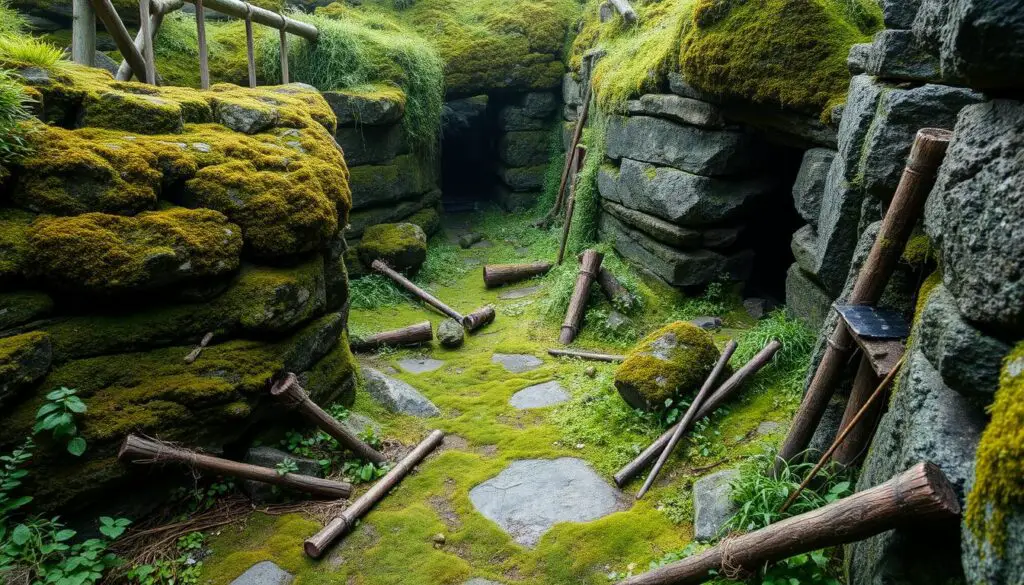
Looking into the Cessair myth means exploring archaeological insight. We see how myths and real artifacts connect.
For example, Mount Sandel shows us when people first lived in Ireland. This could link to or question the Cessair myth.
Investigations and Discoveries
Studies of Ireland’s old past have found important artifacts.
This makes us rethink old stories. Places like Newgrange and the Boyne Valley show us how long people have lived there.
These finds are key to understanding the Cessair myth better.
Interpretations of Artifacts
Looking at these artifacts gives us a peek into early Irish life. Each item tells a story of Ireland’s rich past.
Scholars use these to see how myths like Cessair mix with history.
This way, we learn more about Ireland’s first people. It shows us the deep culture of the country.
The Legacy of Cessair in Contemporary Culture

The story of Cessair has lived through many generations. It has left a lasting mark on Ireland’s culture.
Her story is still felt today in literature and media. It shows Ireland’s deep heritage and changing culture.
Influence on Irish Folklore and Literature
Cessair’s tale is key in Irish folklore. It tells stories that celebrate Ireland’s mythological past.
Christian monks in the 11th century wrote these tales down. This made Cessair’s story a big part of Ireland’s culture.
Today, authors use these old myths to tell new stories. Cessair’s influence is clear in modern literature.
It mixes history with imagination, showing readers Ireland’s mythic roots.
Representation in Modern Media
In our digital world, Cessair’s story is being told in new ways. It’s in podcasts, documentaries, and TV shows.
Her myth draws people from all over the world.
It’s like the stories of Ireland’s invasions and George R.R. Martin’s A Song of Ice and Fire.
These stories talk about moving to new lands and winning over places. Cessair’s journey is still captivating people today.
Media shows like these help people around the world love Irish culture more. They show how powerful these old stories still are.
Common Themes in Irish Mythology: Serpents and Purity

In Irish myths, serpents and purity often go together. They make a rich mix of stories that last for centuries.
These stories tell of a pure Ireland, full of legends.
“We exist in perpetual creative response,” embodies the ever-revolving nature of cultural myths in Ireland, blending ancient spiritual symbols with modern interpretations.
Serpents in stories are both protectors and foes. They are deep in Irish culture.
The story of St. Patrick and the serpents shows how Ireland was seen as pure and sacred.
Serpents and purity show both good and bad in Irish myths.
They tell of change and new starts. This shows a deep care for the earth.
Marisa’s story tells of Cessair’s journey to start anew.
It’s like today’s efforts to care for the earth, as seen in Mary Reynolds’ “Acts of Restorative Kindness,” linking earth care with myth.
- Cessair’s journey cleanses the land for new settlers, showing purity.
- St. Patrick’s story tells of removing serpents, making Ireland pure.
- Floods and new beginnings in myths show the importance of keeping the earth pure.
Serpents and purity in Irish myths stress the need for balance. These stories shape Ireland and its people’s identity.
Conclusion
Cessair’s story shows us the power of ancient tales in Irish mythology.
Her journey from the East to Donemark shows human strength and Ireland’s deep culture.
Her story mixes myth and history, giving us a deep look at her impact.
Irish myths link stories from Wales, Scotland, and Brittany. Legends of Wales, Ireland’s mystical creatures, Scotland’s selkies, and Brittany’s gods share a common story.
This shows us the big themes and stories that connect these tales.
Today, Cessair’s story lives on in many ways. She appears in books, movies, and even in a South Dublin performance.
By looking at ancient settlers and their stories, we keep their tales alive. Cessair’s story shows the lasting magic of Celtic myths.
Frequently Asked Questions
Q: Who is the most powerful god in Irish mythology?
The Dagda is often considered one of the most powerful gods in Irish mythology, known for his control over life, death, weather, and agriculture.
Q: Who is the dark one in Irish mythology?
The Morrigan, also known as the “Phantom Queen,” is often referred to as the dark one due to her association with war, fate, and death.
Q: Who was Noah’s granddaughter in Ireland?
This appears to be a blending of biblical tales and Irish folklore; there is no widely recognized story in Irish mythology or history that directly links Noah’s granddaughter with Ireland.
Q: Who is the Irish mother of god?
In Irish mythology, Danu is often revered as the mother goddess and is associated with the Tuatha Dé Danann, the mythical tribe of gods.
Q: Who are the three goddesses of Ireland?
The three goddesses often referred to in Irish mythology are Ériu, Banba, and Fódla, each representing the sovereignty of Ireland.
Q: Are Irish considered Celtic?
Yes, the Irish are considered Celtic, as their culture, language, and historical origins are part of the broader Celtic heritage that spanned across several regions in Europe.
Q: Who is the main Irish god?
While there is no single main god, The Dagda is a prominent figure in Irish mythology, often considered a chief among the gods due to his wisdom and power.
Q: Are Irish and Celtic gods the same?
Irish gods are part of the Celtic pantheon, which varies slightly between different Celtic cultures such as Welsh, Scottish, and Gaulish, sharing many similarities but also having unique attributes.


